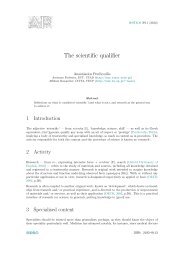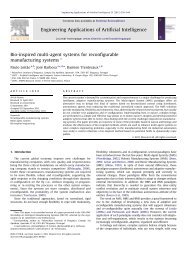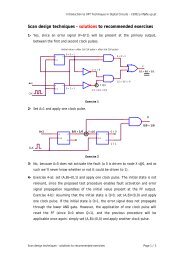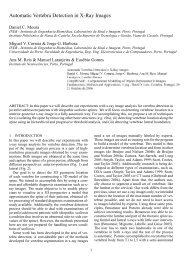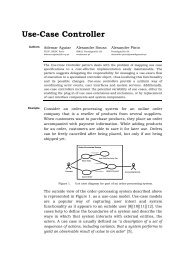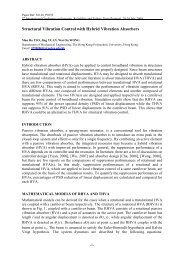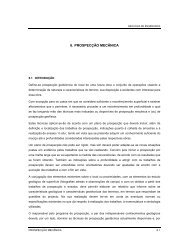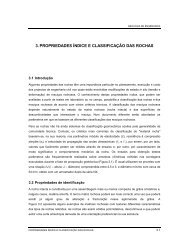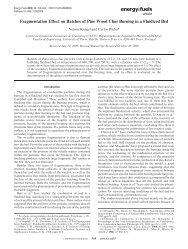- Page 1 and 2:
Lernsystem Automatisierung und Komm
- Page 3 and 4:
Inhaltsverzeichnis A - III Inhaltsv
- Page 5 and 6:
Einleitung A1 - 1 A.1 - Einleitung
- Page 7 and 8:
Arbeits- und Sicherheitshinweise A2
- Page 9 and 10:
Übersicht A3 - 1 A.3 - Übersicht
- Page 11 and 12:
Übersicht A3 - 3 Konfigurationsbei
- Page 13 and 14:
Übersicht A3 - 5 Aufbaubeispiel: D
- Page 15 and 16:
Übersicht A3 - 7 Alle Konfiguratio
- Page 17 and 18:
Mechanischer Aufbau A4 - 1 A.4 - Me
- Page 19 and 20:
Mechanischer Aufbau A4 - 3 A.4.2 -
- Page 21 and 22:
Mechanischer Aufbau A4 - 5 • Fül
- Page 23 and 24:
Bedienelemente A5 - 1 A.5 - Bediene
- Page 25 and 26:
Beschreibung der Regelstrecken A6 -
- Page 27 and 28:
Beschreibung der Regelstrecken A6 -
- Page 29 and 30:
Beschreibung der Regelstrecken A6 -
- Page 31 and 32:
Inbetriebnahme A7 - 1 A.7 - Inbetri
- Page 33 and 34:
Inbetriebnahme A7 - 3 r Mit der Pum
- Page 35 and 36:
Vernetzung mit Profibus A8 - 1 A.8
- Page 37 and 38:
Normen und Richtlinien A9 - 1 A.9 -
- Page 39 and 40:
Fließbilder A10 - 1 A.10 - Rohrlei
- Page 41 and 42:
Fließbilder A10 - 3 A.10.3 - RI -
- Page 43 and 44:
Fließbilder A10 - 5 A.10.5 - RI -
- Page 45 and 46:
EMSR Stellenpläne A11 - 1 A.11 - E
- Page 47 and 48:
EMSR Stellenpläne A11 - 3 A11.3 -
- Page 49 and 50:
Stücklisten A12 - 1 A.12 - Stückl
- Page 51 and 52:
Stücklisten A12 - 3 A.12.3 - Stüc
- Page 53 and 54:
Stücklisten A12 - 5 Festo Didactic
- Page 55 and 56:
Datenblätter A13 - 1 A.13 - Datenb
- Page 57 and 58:
Regler 170696 1/2 Aufbau Der Regler
- Page 59 and 60:
Motorregler 170698 1/1 Aufbau Der M
- Page 61 and 62:
Analog-Terminal 170699 1/1 10VDC 24
- Page 63 and 64:
Verrohrung 170701, 170702, 170703 1
- Page 65 and 66:
Behälter 170707 1/1 Aufbau Der Beh
- Page 67 and 68:
Temperatursensor 170709 1/1 Aufbau
- Page 69 and 70:
Analoger Ultraschallsensor 170710 1
- Page 71 and 72:
Durchflusssensor 170711 1/2 Aufbau
- Page 73 and 74:
Pumpe 170712 1/2 Aufbau Die Pumpe i
- Page 75 and 76:
Heizung 170713 1/1 Aufbau Die Heizu
- Page 77 and 78:
Proportionalventil 170714 1/2 Aufba
- Page 79 and 80:
2/2-Wege-Magnetventil 170715 1/1 Au
- Page 81 and 82:
Kugelhahn 170716 1/1 Aufbau Der Kug
- Page 83 and 84:
Kapazitiver Näherungsschalter 2581
- Page 85 and 86:
Festo Didactic • Process Control
- Page 87 and 88:
Learning system for automation and
- Page 89 and 90:
Table of contents B - III Table of
- Page 91 and 92:
Introduction B1 - 1 B.1 - Introduct
- Page 93 and 94:
Notes on safety and procedure B2 -
- Page 95 and 96:
Overview B3 - 1 B.3 - Overview The
- Page 97 and 98:
Overview B3 - 3 Sample configuratio
- Page 99 and 100:
Overview B3 - 5 Sample construction
- Page 101 and 102:
Overview B3 - 7 All configurations
- Page 103 and 104:
Mechanical assembly B4 - 1 B.4 - Me
- Page 105 and 106:
Mechanical assembly B4 - 3 B.4.2 -
- Page 107 and 108:
Mechanical assembly B4 - 5 • Fill
- Page 109 and 110:
Control elements B5 - 1 B.5 - Contr
- Page 111 and 112:
Description of controlled systems B
- Page 113 and 114:
Description of controlled systems B
- Page 115 and 116:
Description of controlled systems B
- Page 117 and 118: Commissioning B7 - 1 B.7 - Commissi
- Page 119 and 120: Commissioning B7 - 3 r Use pump P t
- Page 121 and 122: Networking with Profibus B8 - 1 B.8
- Page 123 and 124: Standards and directives B9 - 1 B.9
- Page 125 and 126: Flow diagrams B10 - 1 B.10 - Piping
- Page 127 and 128: Flow diagrams B10 - 3 B.10.3 - PI -
- Page 129 and 130: Flow diagrams B10 - 5 B.10.5 - PI -
- Page 131 and 132: EMCS block diagrams B11 - 1 B.11 -
- Page 133 and 134: EMCS block diagrams B11 - 3 B.11.3
- Page 135 and 136: Parts lists B12 - 1 B.12 - Parts li
- Page 137 and 138: Parts lists B12 - 3 B.12.3 - Parts
- Page 139 and 140: Parts lists B12 - 5 Festo Didactic
- Page 141 and 142: Data sheets B13 - 1 B.13 - Data she
- Page 143 and 144: Controller 170696 1/2 Design The co
- Page 145 and 146: Motor regulator 170698 1/1 Design T
- Page 147 and 148: Analogue terminal 170699 1/1 10VDC
- Page 149 and 150: Piping 170701, 170702, 170703 1/2 D
- Page 151 and 152: Container 170707 1/1 Design The con
- Page 153 and 154: Temperature sensor 170709 1/1 Desig
- Page 155 and 156: Analogue ultrasound sensor 170710 1
- Page 157 and 158: Flow sensor 170711 1/2 Design The f
- Page 159 and 160: Pump 170712 1/2 Design The pump is
- Page 161 and 162: Heating unit 170713 1/1 Design The
- Page 163 and 164: Proportional valve 170714 1/2 Desig
- Page 165 and 166: 2/2-way solenoid valve 170715 1/1 D
- Page 167: Ball valve 170716 1/1 Design The ba
- Page 171 and 172: Festo Didactic • Process Control



